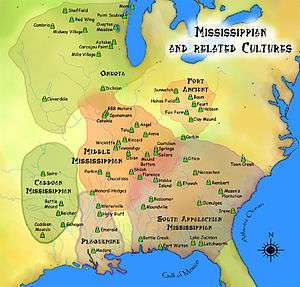Chisca
| Total population | |
|---|---|
| Extinct as a tribe | |
| Regions with significant populations | |
| Tennessee and Virginia | |
| Languages | |
| linguistic affiliation uncertain | |
| Religion | |
| Indigenous religion | |
| Related ethnic groups | |
| Shawnee and/or Yuchi |
The Chisca were a tribe of Native Americans living in eastern Tennessee and southwestern Virginia in the 16th century. They later merged with the Shawnee, and became extinct as a tribe during the 18th century.
Known history
They were encountered by both the Hernando de Soto Expedition in 1542 and the Captain Juan Pardo Expedition in 1568. De Soto sent out a small exploration party in the vicinity of the upper Tennessee River, who were attacked and defeated by Chisca warriors.[1] The experience convinced de Soto to limit explorations in Chisca territory.
Captain Pardo also sent exploration parties that fought with the Chisca (Pardo called them Chisca; his chronicler called them Uchi). His men destroyed their settlement at Maniatique, thought to be at present-day Saltville, Virginia.[2] The name Chisca seldom appeared in Spanish colonial records after the 16th century.
In 1683 the French explorer La Salle found a Cisca village between the Cumberland and Tennessee rivers (in Yuchi territory, now northern Tennessee). He persuaded them and the Shawnee north of the Cumberland to relocate to Fort St. Louis in Illinois and live under French protection. Around this time, these Cisca seem to have joined with the Shawnee under the name Chaskepe. They followed the Shawnee's later migrations (1692–1754) through Virginia, Maryland, Pennsylvania and finally Ohio. La Salle reported that the Chisca had originally lived in the Appalachians east of where he found them, until their town was burnt down by colonists from Florida (he mistakenly called those people English; they were Spanish).[3] The Chisca appeared to have become extinct as a tribe by the 18th century.
See also
Notes
- ↑ Hudson, Knights of Spain, Warriors of the Sun, 203
- ↑ See Robin Beck, "From Joara to Chiaha: Spanish Exploration of the Appalachian Summit Area, 1540–1568", Southeastern Archaeology 16(2) Winter 1997, for a full scholarly discussion of the location of Maniatique.
- ↑ Charles Augustus Hanna, 1911 The Wilderness Trail, Vol II, 1911, pp. 93–95.
References
- Beck, Robin, "From Joara to Chiaha: Spanish Exploration of the Appalachian Summit Area, 1540–1568", Southeastern Archaeology, 16(2) Winter 1997
- Hudson, Charles, The Southeastern Indians, Knoxville,TN: University of Tennessee Press, 1976.
- Hudson, Charles, Knights of Spain, Warriors of the Sun, Athens, GA: University of Georgia Press, 1997.
- Swanton, John R. The Indian Tribes of North America, Washington, DC: Smithsonian Institution Press, 1952.
- Worth, John E. (2004). "Chisca". In Raymond D. Fogelson, ed. Handbook of North American Indians, Vol. 14: Southeast. Washington, D.C.: Smithsonian Institution. pp. 176–77 [unified volume Bibliography, 772–999].

